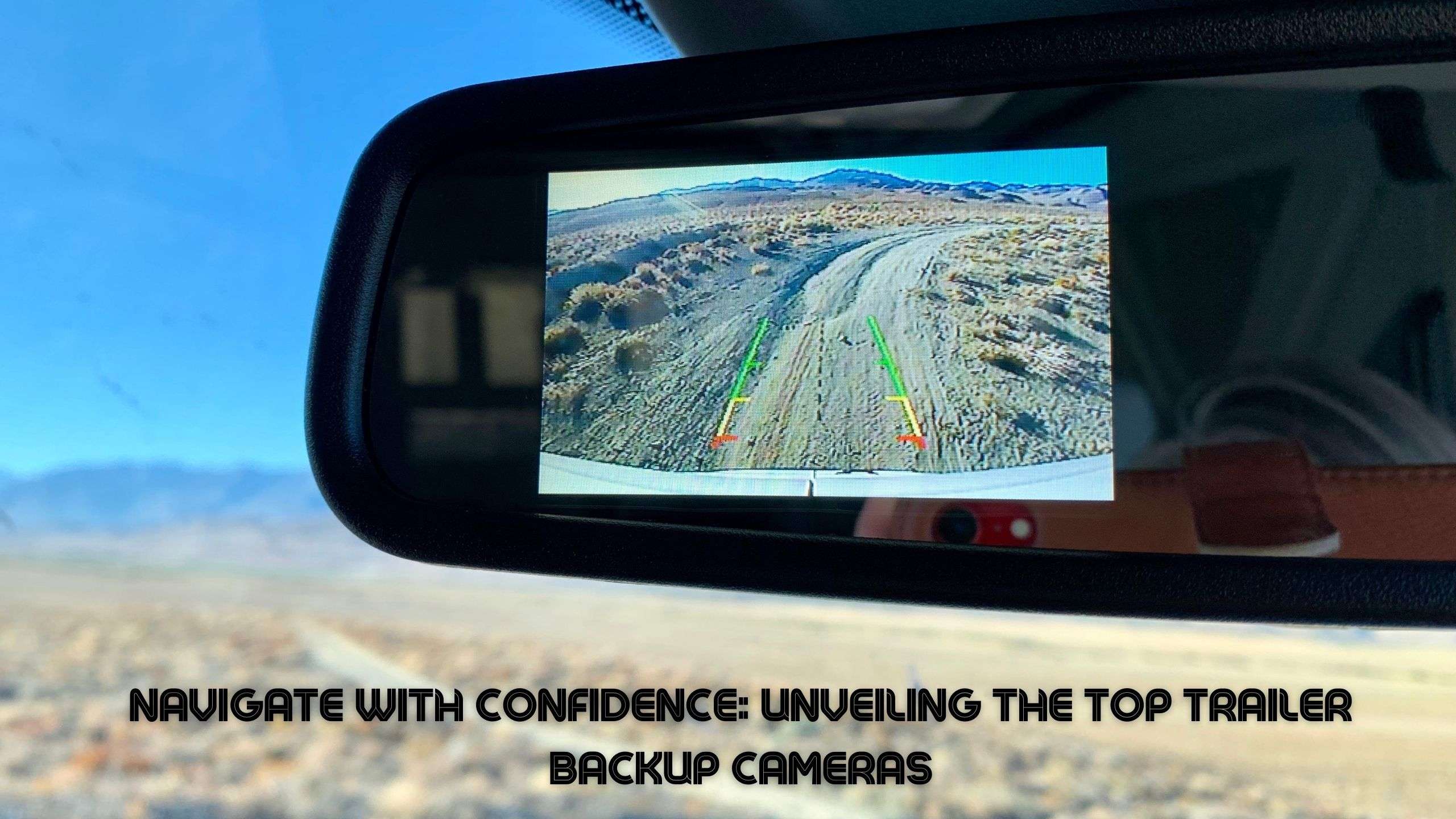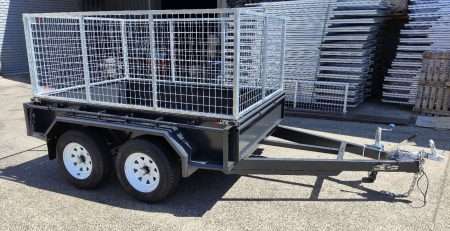
Navigate with Confidence: Unveiling the Top Trailer Backup Cameras
The Importance of Trailer Backup Cameras
In our ongoing mission to make your journey safer and more efficient, we cannot underestimate the significance of trailer backup cameras. These devices offer crucial visibility, allowing drivers to reverse and manoeuvre their trailers with greater confidence and precision.
Understanding Reversing Accidents
The importance of trailer backup cameras becomes glaringly apparent when we consider the statistics surrounding reversing accidents. Tragically, these accidents have caused over 200 fatalities and more than 15,000 severe injuries annually in the US over the last decade. Alarmingly, the majority of victims are children aged 5 years and younger.
Moreover, a study by the Insurance Institute for Highway Safety revealed alarming statistics. In the study, 100 percent of drivers ran over a stationary, child-sized object placed behind them when they turned their heads to look behind them. These accidents are often caused by blind spots and limited visibility when reversing, problems that trailer backup cameras are explicitly designed to address.
Safety Regulations and Backup Cameras
Given the high risk involved in reversing vehicles, especially large ones like trailers, the National Highway Traffic Safety Administration (NHTSA) has stepped in. The NHTSA has mandated that new vehicle models come with backup camera systems by May 2018 due to the safety benefits.
Backup cameras have been shown to reduce backup crashes by up to 46 percent, including injuries to vulnerable people and damage to objects like trash cans and parked cars. Drivers polled by AAA said backup cameras improve the safety of their vehicles by 80 percent and 96 percent of drivers found the technology easy to use.
The incorporation of trailer backup cameras into your vehicle is not just about compliance with regulations but also an investment in safety. By providing clear, real-time visuals of the area behind your trailer, these cameras help prevent accidents, protect lives, and make reversing a much less stressful experience. As we explore the mechanisms and benefits of trailer backup cameras, we hope to help you understand why they are an essential part of today’s trailer equipment.
How Trailer Backup Cameras Work
As we delve deeper into the world of trailer backup cameras, it’s essential to understand the components that make these devices work and the features that set them apart.
Components of a Backup Camera
At the heart of trailer backup cameras is a system that captures and sends images from the camera to the monitor. This process involves light sensors and digital signal processing to create a video image. The camera is often mounted on the rear of the trailer, providing a clear view of what’s behind the trailer to the driver upfront.
The camera’s ability to’see’ through the trailer comes from the use of infrared (IR) light, invisible to the human eye but detectable by the camera. When the IR light hits an object, it reflects off of it and back to the camera, allowing it to create a video image (Kent Faith). This technology is vital in enhancing safety measures when reversing or parking the trailer.
Functionality and Features
Higher-end models of trailer backup cameras offer advanced features such as “Trailer Assist” or “Trailer View.” These cameras capture images from various angles, then stitch them together to create a composite view of the area behind the trailer. They can also use sensors to detect the length and width of the trailer and adjust the view accordingly.
Other models utilise split-screen display technology, showing the view from the backup camera and a separate view from a camera mounted on the back of the trailer side by side. This feature provides a complete picture of what’s happening behind the trailer, significantly improving the driver’s spatial awareness.
Innovations in the industry have led to the development of vehicles equipped with multiple cameras that provide a 360-degree view around the vehicle. Strategically placed cameras capture images from the front, sides, and back, which are then seamlessly stitched together to create a holistic view of the surroundings.
Understanding how these cameras operate and the range of functionalities they offer is pivotal when choosing the best trailer backup camera for your needs. As you navigate your options, consider the unique requirements of your vehicle and the level of visibility you desire to ensure safety and ease of operation. For other trailer-related information and products, such as trailer brake controllers or trailer lights and wiring, feel free to explore our other articles.
Benefits of Installing Backup Cameras
The installation of trailer backup cameras can greatly enhance the safety and convenience of operating a trailer. Let’s delve into the key reasons why we believe these devices are essential for every trailer owner.
Enhanced Safety Measures
First and foremost, backup cameras can significantly reduce backup crashes by up to 46 percent, including injuries to vulnerable people and damage to objects like trash cans and parked cars. Unlike turning your head to look behind, backup cameras can see small objects that may be obstructed by blind spots.
Further demonstrating the safety benefits, a study by the Insurance Institute for Highway Safety showed that 100 percent of drivers ran over a stationary, child-sized object placed behind them when they turned their heads to look behind them. Backup cameras help drivers avoid hitting objects in their path that may not be visible when turning their heads.
In a poll conducted by AAA, drivers said backup cameras improve the safety of their vehicles by 80 percent and 96 percent of drivers found the technology easy to use. Clearly, the addition of a backup camera can be a significant safety upgrade.
Versatility and convenience
In addition to safety, backup cameras can add a great deal of versatility and convenience to your trailer’s use. These cameras can be used for varied purposes, including back-in parking spots, hitching a trailer, and parallel parking. They provide drivers with a new angle of view of their vehicle while still being able to look in front. They are particularly helpful for drivers with back and neck problems, as they allow them to see without rotating their heads.
While backup cameras will become standard in most new vehicles by 2018, they can also be installed in current vehicles at local automotive shops. This means that regardless of the age of your vehicle, you can still reap the benefits of this technology.
The addition of a backup camera can be a worthwhile investment, improving your overall trailer experience. When coupled with other safety equipment such as trailer hitch locks, trailer brake controllers, and trailer safety chains, you can significantly enhance the safety and functionality of your trailer.
Popular Trailer Backup Camera Models
As the market for trailer backup cameras expands, so does the variety of models available. We’ve examined some of the top picks that users and experts have highly recommended to help you sort through the options.
Analysing Top Picks
- Rear View Safety RVS-770613 RV Backup Camera System: This model is a top choice for RV and trailer owners due to its reliability and high-quality video output.
- Furrion Vision S 7-Inch Wireless RV Backup System: Offering a reliable wireless connection between the camera and monitor, this system is easy to install and use, making it a popular choice for many users (RV Lifestyle).
- Haloview MC7108 Wireless RV Backup System: This system boasts an IP69K waterproof rating, ensuring it can withstand different weather conditions. This feature makes it a durable and reliable option for long-term use (RV Lifestyle).
- Yakry HD Backup Camera System: With a 150-degree wide viewing angle, this system provides a broad perspective of the surroundings, enhancing safety when reversing or parking (RV Lifestyle).
- Furrion FOS48TA-BL RV Digital Wireless Observation System: This system features a long-range signal transmission, allowing you to monitor your trailer from a distance. This capability can be particularly useful in large parking lots or when towing large trailers.
Features to Look For
When selecting a backup camera for your trailer, there are a few key features to look for:
- Image Quality: High-resolution cameras provide clearer images, making it easier to spot obstacles when reversing.
- Field of View: A wider field of view offers a larger viewing area, enhancing your overall visibility.
- Wireless vs. Wired: Wireless cameras are easier to install, while wired cameras typically provide a more stable connection.
- Night Vision: This feature allows for better visibility in low-light conditions, enhancing safety during nighttime operations.
- Waterproof Rating: A higher waterproof rating ensures the camera can withstand various weather conditions.
The best trailer backup cameras not only enhance safety but also provide convenience and peace of mind. By evaluating the features and performance of various models, you can find the one that best fits your needs.
Remember, it’s always a good idea to upgrade other trailer parts like trailer hitch locks, trailer brake controllers, and trailer lights and wiring to ensure the overall safety and performance of your trailer.
Installation and maintenance
Once you’ve chosen one of the top trailer backup cameras, the next steps are installation and maintenance. It’s essential to understand the differences between wired and wireless cameras and the importance of regular maintenance to keep your backup camera system functioning optimally.
Wired vs. Wireless Cameras
When considering the installation of backup cameras, two main options exist: wired and wireless systems.
Wired cameras require professional installation due to the complexity involved in running wires from the camera at the rear of the trailer to the monitor at the front. While this might be a more expensive route, wired systems are generally more reliable as they are less prone to signal interference.
On the other hand, wireless cameras can be self-installed, making them a more accessible option for some users (Kent Faith). While they might be more susceptible to signal interference, modern wireless backup cameras have improved significantly in quality, and many offer a stable and clear image.
| Camera Type | Installation | Prone to interference |
|---|---|---|
| Wired | Professional required | Less likely |
| Wireless | Self-installation | More likely |
It’s important to weigh the pros and cons of both systems and choose the one that best suits your needs and budget. Remember, whether you opt for a wired or wireless system, the ultimate goal is to enhance safety when reversing or parking your trailer.
Regular maintenance tips
Like any other component of your trailer, from the heavy-duty trailer hitches to the trailer wheel bearings, regular maintenance is important for backup cameras.
Ensure that the camera lens is clean and unobstructed. Dirt, dust, and road debris can accumulate on the lens over time, affecting the camera’s visibility. Regular cleaning with a soft cloth and a gentle cleaning solution can help maintain the clarity of the image.
Also, consider checking the wiring (for wired systems) or the signal strength (for wireless systems) periodically. This can help identify any potential issues before they become major problems.
Finally, always keep an eye on the monitor’s image quality. If you notice any distortion or discoloration, it might be time for a system check-up or upgrade.
By taking care of your trailer backup camera, you can ensure that it keeps providing you with clear and reliable visibility for a long time to come.
Advanced camera features
In our exploration of trailer backup cameras, it’s important to delve into advanced features that can significantly enhance the usability and safety of these devices. These features, such as ‘Trailer Assist’ and ‘Trailer View’, as well as split-screen and 360-degree view technologies, take backup camera functionality to new levels.
‘Trailer Assist’ and ‘Trailer View’
One of the innovative features we’re seeing in newer models of trailer backup cameras is the ‘Trailer Assist’ or ‘Trailer View’ function. Cameras with this feature can capture images from multiple angles and stitch them together, creating a composite view of the area behind the trailer. They can also adjust the view according to the length and width of the trailer using built-in sensors.
Trailer-mounted cameras, another brilliant addition, provide a clear view of what’s behind the trailer. These cameras are integrated into the vehicle’s backup camera system, displaying the view on the vehicle’s screen. This feature enhances the driver’s awareness, making it easier to navigate even in tight spaces.
Split-screen and 360-degree view
Split-screen display technology is another advanced feature worth mentioning. This technology allows drivers to see both the view from the backup camera and another view from a camera mounted on the trailer’s back. Displayed side by side, these views provide a comprehensive picture of the surroundings.
Meanwhile, the advent of 360-degree view technology has taken trailer backup cameras to another level. Some newer vehicles are equipped with multiple cameras that provide a full view around the vehicle, including the front, sides, and back. These strategically placed cameras create a seamless view of the surroundings, enhancing safety and navigation.
While considering these features, it’s important to remember that not all trailer backup cameras may suit your specific needs. Always consider the type of trailer you have, the conditions you’ll be driving in, and your comfort with technology. Visit our articles on trailer hitch locks and trailer brake controllers for more insights into trailer safety and navigation.
Author
I am Rahatul Ashiq Tamal. Another author of Muscle Trailers. Muscle Trailers is a well-known trailer brand in Sydney, Melbourne & Adelaide

How to Mount a Spare Tire on Your Trailer: A Simple Step-by-Step Guide
Trailer service centers receive over 1 million phone calls and 1.3 million emails each year about trailer maintenance problems....

How to Fix RV Roof Leaks: Simple Roof Leak Detection Guide for Beginners
Did you know DIY RV roof repairs can cost under $50? But undetected leaks could lead to substantially higher repair...

Starting a Food Truck Business in Australia: From Trailer Selection to Launch
The Australian mobile food market has evolved into a billion-dollar industry. This makes a food truck...
